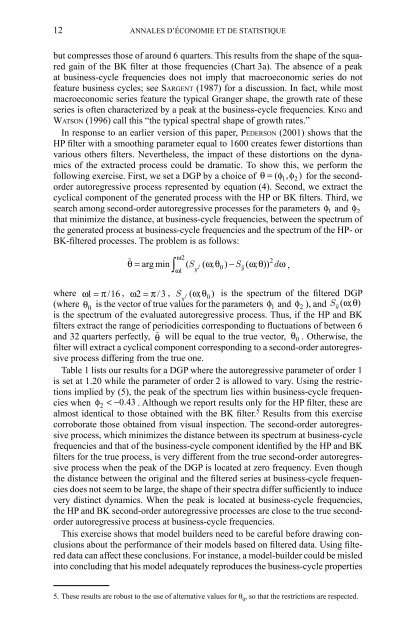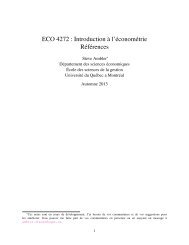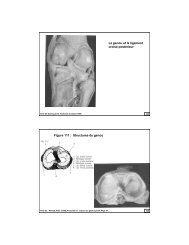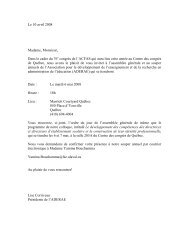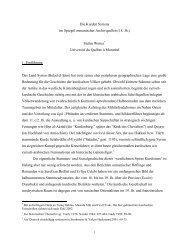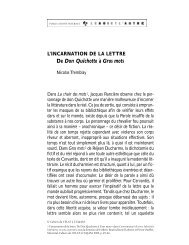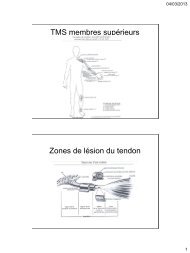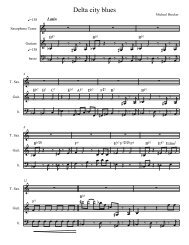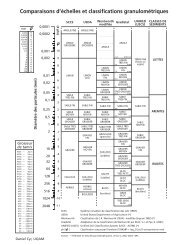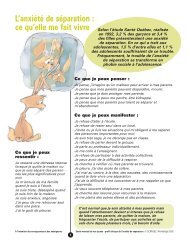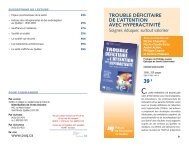Do the Hodrick-Prescott and Baxter-King Filters Provide a ... - UQAM
Do the Hodrick-Prescott and Baxter-King Filters Provide a ... - UQAM
Do the Hodrick-Prescott and Baxter-King Filters Provide a ... - UQAM
Create successful ePaper yourself
Turn your PDF publications into a flip-book with our unique Google optimized e-Paper software.
12 ANNALES D’ÉCONOMIE ET DE STATISTIQUE<br />
but compresses those of around 6 quarters. This results from <strong>the</strong> shape of <strong>the</strong> squared<br />
gain of <strong>the</strong> BK filter at those frequencies (Chart 3a). The absence of a peak<br />
at business-cycle frequencies does not imply that macroeconomic series do not<br />
feature business cycles; see SARGENT (1987) for a discussion. In fact, while most<br />
macroeconomic series feature <strong>the</strong> typical Granger shape, <strong>the</strong> growth rate of <strong>the</strong>se<br />
series is often characterized by a peak at <strong>the</strong> business-cycle frequencies. KING <strong>and</strong><br />
WATSON (1996) call this “<strong>the</strong> typical spectral shape of growth rates.”<br />
In response to an earlier version of this paper, PEDERSON (2001) shows that <strong>the</strong><br />
HP filter with a smoothing parameter equal to 1600 creates fewer distortions than<br />
various o<strong>the</strong>rs filters. Never<strong>the</strong>less, <strong>the</strong> impact of <strong>the</strong>se distortions on <strong>the</strong> dynamics<br />
of <strong>the</strong> extracted process could be dramatic. To show this, we perform <strong>the</strong><br />
following exercise. First, we set a DGP by a choice of θ = ( φ1, φ 2)<br />
for <strong>the</strong> secondorder<br />
autoregressive process represented by equation (4). Second, we extract <strong>the</strong><br />
cyclical component of <strong>the</strong> generated process with <strong>the</strong> HP or BK filters. Third, we<br />
search among second-order autoregressive processes for <strong>the</strong> parameters φ 1 <strong>and</strong> φ 2<br />
that minimize <strong>the</strong> distance, at business-cycle frequencies, between <strong>the</strong> spectrum of<br />
<strong>the</strong> generated process at business-cycle frequencies <strong>and</strong> <strong>the</strong> spectrum of <strong>the</strong> HP- or<br />
BK-filtered processes. The problem is as follows:<br />
ω2<br />
2<br />
θ % = arg min ∫ ( S ( ω; θ0) −S ( ; ))<br />
1 y f y%<br />
ω θ dω<br />
,<br />
ω<br />
where ω 1 = π /16 , ω 2 = π / 3 , S f ( ω; θ 0 ) is <strong>the</strong> spectrum of <strong>the</strong> filtered DGP<br />
y<br />
(where θ 0<br />
is <strong>the</strong> vector of true values for <strong>the</strong> parameters φ 1 <strong>and</strong> φ 2 ), <strong>and</strong> Sy%<br />
( ω; θ)<br />
is <strong>the</strong> spectrum of <strong>the</strong> evaluated autoregressive process. Thus, if <strong>the</strong> HP <strong>and</strong> BK<br />
filters extract <strong>the</strong> range of periodicities corresponding to fluctuations of between 6<br />
<strong>and</strong> 32 quarters perfectly, θ % will be equal to <strong>the</strong> true vector, θ 0 . O<strong>the</strong>rwise, <strong>the</strong><br />
filter will extract a cyclical component corresponding to a second-order autoregressive<br />
process differing from <strong>the</strong> true one.<br />
Table 1 lists our results for a DGP where <strong>the</strong> autoregressive parameter of order 1<br />
is set at 1.20 while <strong>the</strong> parameter of order 2 is allowed to vary. Using <strong>the</strong> restrictions<br />
implied by (5), <strong>the</strong> peak of <strong>the</strong> spectrum lies within business-cycle frequencies<br />
when φ 2 < − 0.43 . Although we report results only for <strong>the</strong> HP filter, <strong>the</strong>se are<br />
almost identical to those obtained with <strong>the</strong> BK filter. 5 Results from this exercise<br />
corroborate those obtained from visual inspection. The second-order autoregressive<br />
process, which minimizes <strong>the</strong> distance between its spectrum at business-cycle<br />
frequencies <strong>and</strong> that of <strong>the</strong> business-cycle component identified by <strong>the</strong> HP <strong>and</strong> BK<br />
filters for <strong>the</strong> true process, is very different from <strong>the</strong> true second-order autoregressive<br />
process when <strong>the</strong> peak of <strong>the</strong> DGP is located at zero frequency. Even though<br />
<strong>the</strong> distance between <strong>the</strong> original <strong>and</strong> <strong>the</strong> filtered series at business-cycle frequencies<br />
does not seem to be large, <strong>the</strong> shape of <strong>the</strong>ir spectra differ sufficiently to induce<br />
very distinct dynamics. When <strong>the</strong> peak is located at business-cycle frequencies,<br />
<strong>the</strong> HP <strong>and</strong> BK second-order autoregressive processes are close to <strong>the</strong> true secondorder<br />
autoregressive process at business-cycle frequencies.<br />
This exercise shows that model builders need to be careful before drawing conclusions<br />
about <strong>the</strong> performance of <strong>the</strong>ir models based on filtered data. Using filtered<br />
data can affect <strong>the</strong>se conclusions. For instance, a model-builder could be misled<br />
into concluding that his model adequately reproduces <strong>the</strong> business-cycle properties<br />
5. These results are robust to <strong>the</strong> use of alternative values for θ 0<br />
, so that <strong>the</strong> restrictions are respected.


